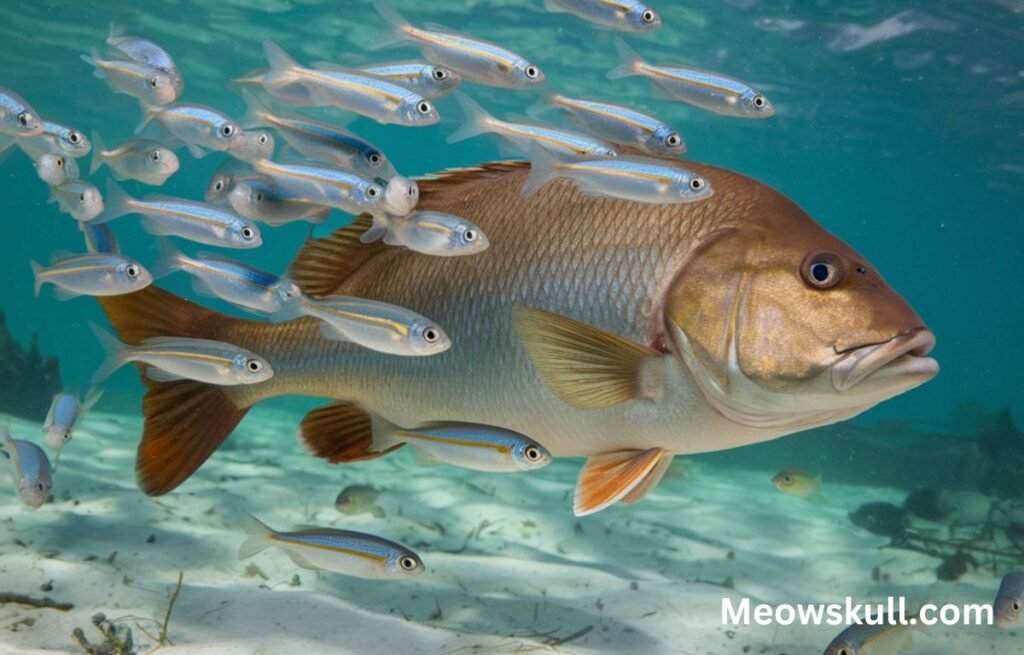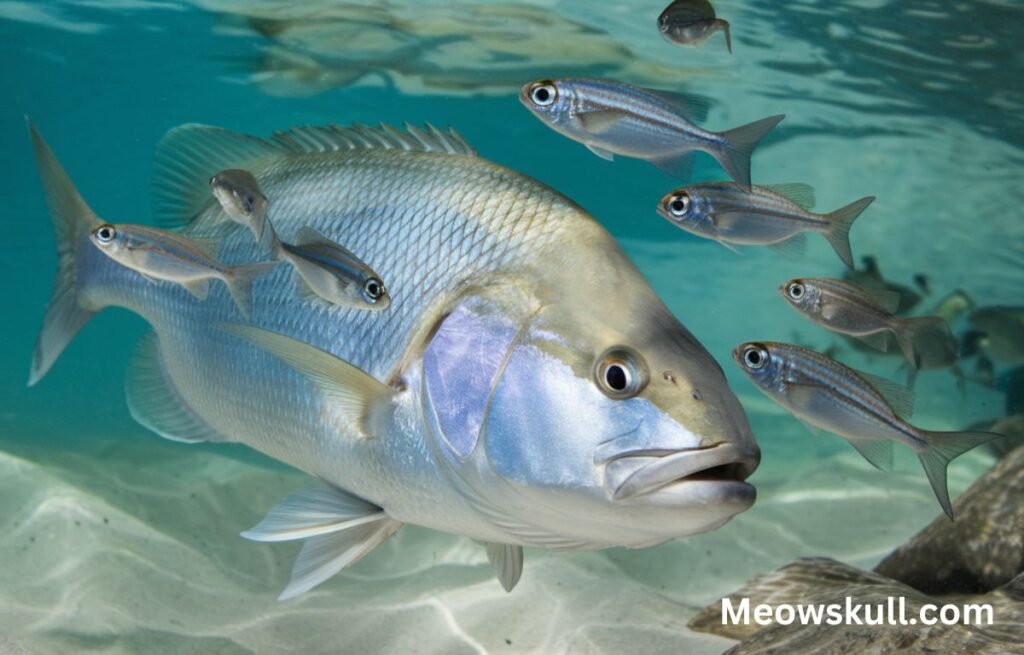Escort fish are a group of small marine fish known for their unique behavior. They often swim with larger fish, helping to clean their skin and gills. This mutual relationship benefits both the escort fish and the larger fish. By providing this service, escort fish get protection and food. Understanding escort fish helps us appreciate the complex interactions in marine life.
These fish are crucial for maintaining healthy ocean ecosystems. They play a role in controlling parasites on larger fish, which keeps the bigger fish healthy. This relationship highlights the importance of every species in the ocean. Protecting escort fish helps ensure a balanced marine environment. Their role is a small but vital part of the underwater world.
Scientific Classification
Escort fish belong to the family Labridae, which includes various species commonly known as wrasses. These fish are characterized by their small size, colorful appearance, and distinctive body shape. They have fins and scales that help them swim efficiently and blend into their environment. The scientific name of escort fish varies depending on the specific species.
In terms of taxonomy, escort fish are classified under the order Perciformes, a large group of fish with many diverse species. They are closely related to other reef fish, sharing similar physical traits and behaviors. Understanding their classification helps scientists study their evolution and ecological role. This classification also aids in conservation efforts by identifying the specific needs and threats facing different species.
Also Read: Lookmovies2: Features, Safety, and Alternatives
Habitat and Distribution

Escort fish are commonly found in coral reefs and kelp forests across the world’s oceans. They prefer warm, shallow waters where they can easily find food and shelter. These fish are often seen around reefs in tropical and subtropical regions, where they interact with various marine species. They can also be found in rocky areas and seagrass beds.
Their distribution ranges from the Indo-Pacific region to the Atlantic Ocean. Depending on the species, escort fish can be found in different locations within these areas. Their habitat preferences make them an important part of the reef ecosystem, contributing to the health and diversity of marine environments. Understanding their habitat helps in protecting the areas they depend on for survival.
Behavior and Social Structure
Escort fish exhibit fascinating social behaviors, often forming groups around larger fish or specific cleaning stations. They work together to remove parasites and dead skin from their hosts, showcasing a unique form of mutualism. This behavior not only benefits the larger fish but also helps escort fish access food sources and protection from predators.
Within their groups, escort fish display a hierarchical social structure, with some fish taking on more dominant roles. They use vocalizations and body language to communicate and coordinate their activities. This organized behavior highlights their social complexity and the importance of their interactions with other marine life. Understanding these behaviors helps in appreciating their role in maintaining marine ecosystems.
Diet and Feeding Habits
Escort fish primarily feed on parasites and dead skin found on the bodies of larger fish. They have specialized mouths and teeth adapted for scraping and cleaning, which allows them to efficiently remove these unwanted materials. This feeding habit provides them with essential nutrients and helps keep their host fish healthy.
In addition to parasites, escort fish may also consume small invertebrates and plankton that they encounter while cleaning. Their diet varies depending on their environment and the availability of food sources. By maintaining this diet, escort fish play a crucial role in the health of coral reefs and other marine ecosystems.
Also Read: Explore Cursed-Memes.com Technology
Reproduction and Life Cycle

Escort fish typically reproduce through external fertilization, where eggs are released into the water and fertilized by sperm from the males. They often lay their eggs in protected areas, such as crevices in the reef or amongst seaweed, to increase the chances of survival. The eggs hatch into larvae, which eventually develop into juvenile fish.
As they grow, escort fish go through several stages of development. Juvenile fish gradually adopt the adult coloration and behaviors necessary for their roles in the ecosystem. Their life cycle involves various changes in size, appearance, and behavior, adapting them to different stages of their lives. Understanding their reproduction and growth helps in efforts to conserve and protect these important marine species.
Ecological Role
Escort fish play a crucial role in marine ecosystems by acting as cleaners for larger fish. They help remove parasites and dead skin, which keeps the larger fish healthy and reduces the spread of diseases. This cleaning relationship is essential for maintaining the balance and health of coral reefs and other marine habitats.
By performing these cleaning services, escort fish also help in maintaining the biodiversity of their environments. They support the overall health of the ecosystem, which in turn benefits other marine species. Their role emphasizes the interconnected nature of ocean life and highlights the importance of preserving healthy marine environments for all species involved.
Conservation Status
The conservation status of escort fish varies depending on the species and their habitat. Some escort fish are considered stable and are not currently facing significant threats. However, others may be at risk due to factors such as habitat destruction, overfishing, and pollution. Coral reef degradation, in particular, can impact the availability of their cleaning stations and breeding grounds.
Efforts to conserve escort fish involve protecting their natural habitats and addressing threats to marine ecosystems. Conservation measures may include establishing marine protected areas and promoting sustainable fishing practices. By safeguarding these habitats and addressing environmental issues, we can help ensure the long-term survival of escort fish and maintain the health of marine ecosystems.
Also Read: www.hura-watch.net Business Archives: A Comprehensive Overview
Research and Studies

Recent research on escort fish has provided valuable insights into their behavior and ecological role. Studies have focused on their cleaning interactions with larger fish and the impact of these relationships on marine health. Researchers have also investigated their social structures and communication methods, revealing complex behaviors and group dynamics.
Notable studies have explored the effects of environmental changes on escort fish populations and their habitats. These findings help in understanding how changes like coral reef decline or pollution affect their survival. Continued research is crucial for developing effective conservation strategies and ensuring the protection of escort fish and their ecosystems.
Conclusion
Escort fish play a vital role in maintaining the health of marine ecosystems through their cleaning interactions with larger fish. Their behavior, diet, and social structures are integral to the balance of coral reefs and other marine environments. Understanding these aspects highlights the importance of their conservation and the protection of their habitats.
Efforts to conserve escort fish and their environments are crucial for sustaining marine biodiversity. By addressing threats such as habitat destruction and pollution, we can help ensure the long-term survival of these important fish. Protecting escort fish ultimately supports the health and stability of the broader marine ecosystem, underscoring the interconnected nature of ocean life.
FAQs
What are escort fish?
Escort fish are small marine fish known for their role in cleaning larger fish by removing parasites and dead skin. They are often found in coral reefs and kelp forests, where they maintain healthy relationships with their host fish. This mutualistic behavior benefits both the escort fish and the larger fish they clean.
Where do escort fish live?
Escort fish primarily inhabit coral reefs, kelp forests, and other marine environments that provide ample opportunities for cleaning interactions. They are commonly found in warm, shallow waters across the Indo-Pacific region and parts of the Atlantic Ocean. Their distribution is closely linked to the availability of suitable cleaning stations and food sources.
How do escort fish reproduce?
Escort fish reproduce through external fertilization, where eggs are released into the water and fertilized by males. They lay their eggs in protected areas like reef crevices or among seaweed. The eggs hatch into larvae, which eventually develop into juvenile fish and mature into adults.
What do escort fish eat?
Escort fish primarily feed on parasites and dead skin from larger fish. They also consume small invertebrates and plankton that they encounter while cleaning. Their diet is essential for their survival and helps maintain the health of their host fish and the broader marine ecosystem.
Why are escort fish important to marine ecosystems?
Escort fish play a crucial role in marine ecosystems by helping to keep larger fish healthy. Their cleaning activities reduce the spread of parasites and diseases, which supports the overall health of coral reefs and other marine habitats. They also contribute to the biodiversity and balance of their environments.
What threats do escort fish face?
Escort fish face threats such as habitat destruction, pollution, and overfishing. Coral reef degradation and environmental changes can impact their cleaning stations and breeding grounds, potentially affecting their populations. Addressing these threats is important for their conservation and the health of marine ecosystems.
How can we protect escort fish?
Protecting escort fish involves conserving their habitats, such as coral reefs and kelp forests, and addressing environmental issues like pollution and overfishing. Establishing marine protected areas and promoting sustainable fishing practices are key measures in safeguarding these fish and their ecosystems.
What have recent studies revealed about escort fish?
Recent studies have provided insights into the behavior, social structures, and ecological roles of escort fish. Research has explored their cleaning interactions, communication methods, and the effects of environmental changes on their populations. These findings are essential for developing effective conservation strategies.
Are escort fish endangered?
The conservation status of escort fish varies by species. While some are stable, others may face risks due to habitat loss, pollution, or overfishing. Monitoring their populations and implementing conservation measures are crucial for ensuring their long-term survival.
How do escort fish interact with larger fish?
Escort fish interact with larger fish by cleaning them of parasites and dead skin. This mutualistic relationship benefits both parties: the larger fish receive hygiene services, while the escort fish gain access to food and protection. These interactions are a key aspect of their role in marine ecosystems.

As a seasoned contributor to “Meowskull”, Rosalie combines her linguistic prowess with a keen understanding of various topics, ensuring a delightful and informative reading experience. Her articles effortlessly blend clarity, creativity, and a touch of elegance, making language exploration an exciting journey for readers.